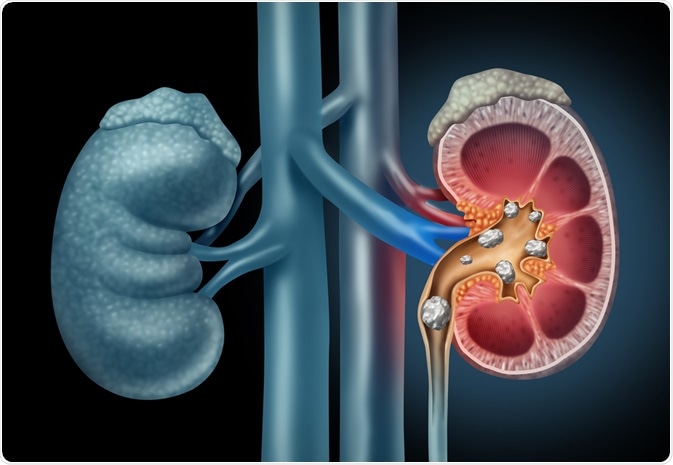Cystinuria is a health condition characterized by increased concentration of cystine and other dibasic amino acids in the urine. It most commonly occurs in young adults between the age of twenty and thirty years, although it may be present in some individuals children or in adolescence.
As a stand-alone condition, cystinuria does not usually cause symptoms, but it can lead to the formation of kidney stones, which can be troublesome for patients and make a severe impact on their quality of life.
The diagnosis of cystinuria typically involves a consultation about the family and medical history, in addition to diagnostic tests that can help to confirm the origin of the symptoms. These tests often include an analysis of a urine sample in a laboratory and imaging scans to control structural changes in the kidneys.
 Cystinuria can cause kidney stones made of cystine. Image Credit: Lightspring / Shutterstock.com
Cystinuria can cause kidney stones made of cystine. Image Credit: Lightspring / Shutterstock.com
Symptoms of cystinuria
Cystinuria can be asymptomatic when there are no stones in the kidneys, but most people with cystinuria eventually experience the formation of stones, which leads to the presentation of symptoms. These may include:
- Blood in urine
- Severe pain in the back (usually unilateral, on one side)
- Nausea
- Vomiting
- Abdominal pain
Homozygous cystinuria involves chronic, recurrent kidney stones and can be difficult to manage effectively. Medical and surgical interventions may help the stones to disappear and to resolve symptoms temporarily, but the recurrent nature of the condition reignites the cycle.
Initial consultation for cystinuria
Most patients that present with cystinuria are experiencing symptoms as a result of cystine stones in the kidneys. The diagnosis of the condition involves a consultation about their symptoms and medical history, followed by an examination with relevant diagnostic testing.
There are several health conditions that are associated with cystinuria, and specific questions should be posed about these should be posed to establish a full understanding of the individual's overall health. For example, many patients also present with renal colic and some may be affected by hematuria, backache or urinary tract infection, which are also linked to cystinuria.
As it is an inherited genetic condition, it is important to establish the family medical history, particularly if any close family members have experienced similar symptoms or were affected by cystinuria.
Urine tests for cystinuria
Urinalysis is the analysis of the urine in a laboratory. Various characteristics of the urine are examined, including the color, appearance and chemical composition. It is common practice for the urine to be viewed with a microscope and a series of chemical tests to be conducted in the full analysis.
The collection of all urine over a 24-hour period can be collected and sent to a laboratory to be analyzed for abnormalities suggestive of cystinuria.
What is Cystinuria?
Diagnostic imaging of cystinuria
Intravenous pyelogram is a procedure that involves the administration of a dye into the bloodstream, which is then followed with X-ray imaging to observe the movement throughout the renal system.
Computed tomography (CT) scans of the abdominal region can be used to obtain a sharper image of the kidney structure and any changes as a result of cystine stones formation in the kidneys.
With the application of these diagnostic tests, it is usually possible to acquire a clear picture of the individual’s condition. This is very helpful to aid the best therapeutic decisions to manage the symptoms.
References
Further Reading